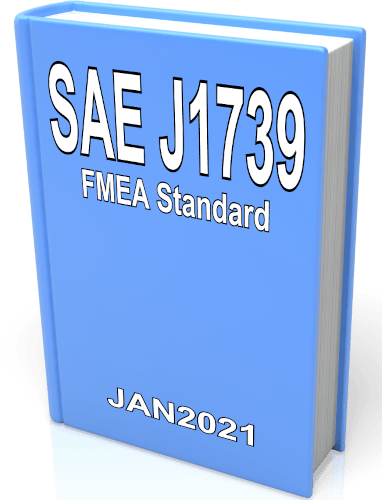
The New SAE J1739 FMEA Standard Has Been Released – What Does It Mean?
The long-awaited revision to the 2009 SAE J1739 FMEA Standard was released in January of 2021. The revised SAE J1739 standard titled “Potential Failure Mode and Effects Analysis (FMEA) Including Design FMEA, Supplemental FMEA-MSR, and Process FMEA JAN2021” (“JAN2021 J1739 FMEA Standard”) has a significant number of changes when compared to the 2009 version. Over the upcoming weeks, we are going to examine the JAN2021 J1739 FMEA Standard in detail through a series of articles. This is the first of those articles.
Historical Relationship Between the SAE J1739 FMEA Standard and AIAG FMEA Manual
For the 18 years prior to the publication of the AIAG VDA FMEA Handbook in 2019, the current version of the SAE J1739 FMEA Standard was always the technical equivalent of the current AIAG FMEA Manual. The 2009 version of the SAE J1739 FMEA Standard was closely aligned with the AIAG 4th Edition FMEA manual published in 2008.
This changed with the publication of the AIAG VDA FMEA Handbook. Despite the claims of the committee who created it that the handbook represented a harmonization of the AIAG FMEA and VDA (“Verband de Automobilindustrie”, German Association of the Automotive Industry) FMEA methodologies, it was an adoption of the VDA FMEA methodology. Because of this, the methodology presented in the AIAG VDA FMEA Handbook was significantly different than the FMEA methodologies found in the 2008 AIAG 4th Edition FMEA Manual and 2009 J1739 FMEA Standard.
With half of the members of the JAN2021 J1739 FMEA Standard committee also being members of the AIAG VDA FMEA Manual committee, the question that everyone wanted answered was how it would compare with the new AIAG VDA FMEA Manual.
Influence of AIAG VDA FMEA Manual Committee Members on Standard
The influence of the AIAG VDA FMEA Manual Committee members on the JAN2021 J1739 FMEA Standard is significant. It had to be. The VDA FMEA methodology is based on software first released for sale in 1992. Unless core principles of the VDA methodology were included in the JAN2021 J1739 FMEA Standard, the many millions of dollars invested in the VDA software since 1992 would be lost. In responding to a Quality Digest article “The Case Against the AIAG VDA Design FMEA” which described the weaknesses of the VDA Design FMEA methodology adopted in the handbook, Mike Bucala, a VDA member of the AIAG VDA FMEA Handbook Committee, stated:
“Your article concludes that the team should have started with (Excel-based) AIAG 4th Edition methods, and (by inference) expected the Europeans to modify their software-based methods to conform to it. This in an unrealistic expectation.”
Method of Analysis
The J1739 Standard covers three different types of FMEAs: DFMEA, DFMEA-MSR and PFMEA. The analysis in future weeks will examine the standard’s handling of each of these three FMEA types separately in detail. While analyzing the different FMEA types, the analysis will include a comparison of the JAN2021 J1739 FMEA Standard FMEA methodologies and the AIAG VDA FMEA Handbook FMEA methodologies.
J1739 DFMEA Methodology Analysis Topic: What Is A Design FMEA?
Before one can begin an analysis of the JAN2021 J1739 FMEA Standard Design FMEA methodology, one must answer the question “What Is A Design FMEA?”. Improper definition of what a Design FMEA is can lead to it being performed at the wrong time as well as being done incorrectly.
Please read the article “What is a Design FMEA?” that defines what the JAN2021 J1739 FMEA Standard says a Design FMEA is and analyzes whether or not the definition is accurate.
Sign Up For New J1739 Articles
This is the first in a series of articles on the SAE J1739 FMEA standard. If you’d like to be notified of new articles, fill out the form below.
